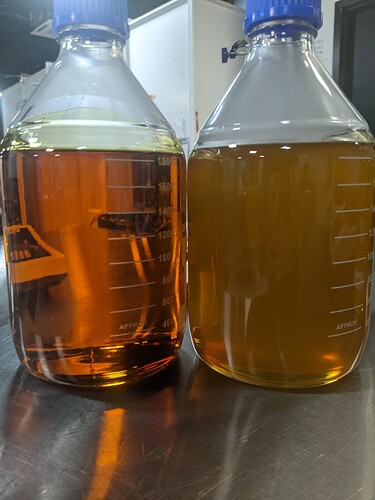Our lab currently makes CO2 distillate with the process of extraction, ETOH dissolve, winterize, filter plant fats, carbon filter, rotovape, then distillation. We are looking into making BHO distillate as well. How does the post-extraction process differ from the CO2 process? Thanks!
It doesnt differ much at all.
But here are some things to note:
Alcohol will pull more terps
Bho will pull more fats/waxes
Co2 will pull a dirty mix of both. (You can make a clean co2 extract with more effort however its rarely done)
Ok, that’s what I’m gathering from my research. Thank you, much appreciated.
I would suggest you at least look at extracting with Ethanol as your primary solvent.
rather than CO2 then ethanol, or Hydrocarbon, then ethanol, why not just ethanol?
We are looking into getting an ethanol extraction setup in the future, but for now we have access to CO2 and butane machines so that’s what we’re rolling with.
…and then you’re going to use ethanol.
so you’ll end up with some of the gear you need for extracting with ethanol.
if you choose your path wisely, you can leverage that gear when you scale up.
you can extract with ethanol in your hydrocarbon rig. including solvent recovery.
depending on your CO2 rig, you might want to look into CXE.
So you would pump in cold ethanol into the cls stripping the material and then how would you recover the ethanol?
same way you recover your hydrocarbons.
heat the receiver & cool the recovery tank.
I’ve done passive & active.
only thing that changes is the temps required.
adding another condenser helps.
Into a regular recovery tank?
I was using a 2015 PX1.
Which has a jacketed solvent tank and sight glasses. Filled that with ethanol, got it to -30C, used N2 to push it through.
Recovered into same vessel.
Done deliberately to bamboozle the boss in my case. I was told to “make shatter”.
We were not licensed for hydrocarbons, so I didn’t use them. Boss couldn’t tell the difference while extracting, and EHO makes a lovely shatter, so he couldn’t tell when I was done either.
The shotgun style heat exchanger I added to make it run faster helped with passive hydrocarbon recovery too…
Were the pressures the same in recovery of the etoh vs the hydrocarbon gas? I am interested in repurposing a rig I have for etoh instead of running isobutane
I either used vacuum assist or a recovery pump to keep temps manageable.
I’d probably leave the recovery tank open to atmosphere if I wasn’t using a pump to reduce the boiling point.
So I’m coming from a somewhat similar situation. Had been using Co2 to make distillate (same process without the carbon filter in our case).
Now I’m being asked to make distillate from BHO crude oil. I’ve made some batches and everything has been jolly. NOTE I am not winterizing. I am running AA and T5 in my CRC stack, purging in a vac oven, decarbing on a hot plate, then running into distillate.
Recently I’ve had 2 batches of BHO starting distillate fog up on me! My fist suspicion is that its fats crashing out. (pics attached).
Do we think that is fats?
Is the solution dissolving in ETOH and winterizing?
Is @cyclopath right that we should just dissolve in ETOH in the first place?
How did this end up for @Leota21 in the end?
You can run ETOH through a BHO setup?!
Every time I come here for an answer I leave with more questions.
What are your extraction temperatures like? And what is the contact time between the bud and the liquid butane?
Also, what are you using to distill? short path? wiped film?
yes.
if you are making distillate from BHO, and it’s good enough that you don’t need to winterize, you’ve left too much behind in the biomass.
if your goal is to make distillate, then using ethanol as your primary extraction solvent makes more sense than using CO2 (imo), and in most cases it also makes better sense than using butane/propane.
if what you’ve got is a source of crude, then winterize. if you’re also making the crude, sitting down and looking at the cost/logistics of making that crude with ethanol is likely worthwhile.
Fats and waxes for sure
Winterizing between first and second pass is the smallest volume to winterize
So if fats and waxes are ending up in your distillate fraction, it means they’re actually being vaporized at cannabinoid distillation temperatures? IIRC, most of the waxes are C38 waxes or even higher alkanes, which boil at >500C (at atmospheric pressure).
Huh. Interesting. I figured they would stay in the residue (the stuff that doesn’t vaporize) fraction.
I have chillers all over at -20C and a cooling coil that my butane goes over just before touching biomass that is Dry Ice in Iso which should be at -40C.
For distilling I use a Prescott Wipe film.
ALSO @cyclopath @Roguelab I left out a huge piece of info. The two disty batches in the image looked exactly the same yesterday, both cloudy and weird. I heated the one on the left up to about 60C and the cloudiness vanished.
Does the added info change anyone’s mind?
Dry ice and EtOH or ISO should hit -70 C (theoretically -78)
Do you have the ability to extract colder? You can almost completely mitigate your wax extraction at low temps (as people mentioned before, at the sacrifice of efficiency)

